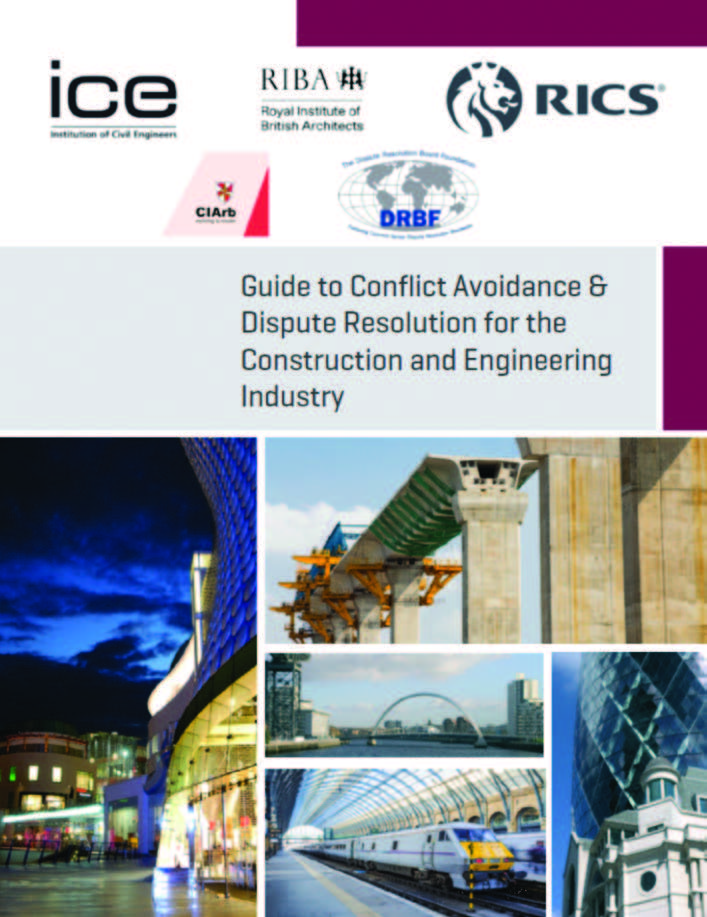
In January 2018 the Conflict Avoidance Coalition Steering Group (CACSG), of which the Institution of Civil Engineers, the NEC parent, is a member, launched the Conflict Avoidance Pledge to reduce the cost and frequency of construction disputes (RICS, 2022). Over 280 organisations have signed the pledge to date.
The initiative recognises the substantial financial cost of construction disputes and the harmful effect this has on business relationships and reputations. This thinking, and the recommended use of contractual mechanisms, is very much in line with and supported by the NEC suite of contracts.
It is therefore useful, and important for all NEC users, to understand what methods NEC4 uses to achieve the aims of the pledge.
Conflict Avoidance Pledge
Signing the pledge is an indication that a party is committed to maintaining good business relationships by dealing with problems early and amicably. It confirms that the party:
- believes in collaborative working and the use of early intervention techniques throughout the supply chain to resolve differences of opinion before they escalate into disputes
- recognises the importance of embedding conflict-avoidance mechanisms, and the appropriate resources, to identify, control and manage potential conflict, while preventing the need for formal and adversarial dispute resolution procedures
- is committed to working proactively to avoid conflict and to facilitate early dispute resolution, as well as developing its capabilities in the early identification of potential disputes and in the use of conflict avoidance measures. This involves promoting the value of collaborative working and working with industry partners to identify, promote and utilise conflict avoidance mechanisms.
Signatories to the pledge are supported by a 16-page guide (ICE, RIBA, RICS, CIArb and DRBF, 2016), which summarises the major benefits of five techniques for avoiding conflict and resolving disputes early, including contractual provisions and dispute avoidance boards. For example, the guide highlights the need for contracts to be written in plain, simple English, avoiding legal terms and jargon, so they can be read and understood by everyone using it. This is a key principle of the NEC suite of contacts.
There is also an 11-page Conflict Avoidance Toolkit (CACSG, 2019), which provides further guidance from pre-contract preparation to dispute resolution. It states for example that a contract should include a viable compensation event procedure, which aims to establish the cost and time effects of changes at the time each change occurs. Again, this is very much in line with the approach taken in NEC4.
NEC dispute avoidance provisions
When it comes to NEC4, parties that behave in accordance with the obligation to act in a, ‘spirit of mutual trust and co-operation’ are likely to take the necessary steps that will avoid disputes or help resolve them without an adverse impact on their relationship. But there are other provisions that are consistent with and aimed at achieving the same objectives as the Conflict Avoidance Pledge.
The guide highlights the importance of early warnings and provides the NEC early warning mechanism as an example of what is required. This is set out in clause 15 of NEC4 contracts, which ensures that issues that affect the cost, duration and performance of the works are identified early and a discussion takes place to see what steps can be taken to reduce the potential impact. This is aimed at finding the best solution for all, which may or may not involve additional compensation, which means issues are dealt with early, reducing their impact and the risk that they will only come up at a late stage. Working together to reduce the impact is likely to help resolve amicably any issues as to liability, or at the very least narrow the issues to be resolved and provide more clarity on what issues may be in dispute.
Indeed, disputes are often caused or exacerbated by a lack of knowledge as to what is happening on site or the true progress of the works. Under NEC4, the overall emphasis on transparency and continuing communications, as well as the joint use of the accepted programme, not only ensures collaboration but provides more certainty as to the state of the works. That in turn will help reduce disputes or narrow their scope. Similarly, the new clause 50.9 introduced in the NEC4 Engineering and Construction Contract Options C and D (target contracts) and E (cost reimbursable contract) allows a contractor to raise and finalise its defined cost at an earlier stage, reducing the risk of new issues being raised at a late stage when they are less easy to resolve.
The most relevant provision is secondary option W on resolving and avoiding disputes. Options W1 and W2 both provide for disputes to be referred to senior representatives, with a process based on statements of case being presented and discussions taking place within a fixed timetable. This leads to a list of issues agreed and issues not agreed, which is an effective way to reduce the scope of disputes which need to progress to more formal proceedings.
Option W3 provides an alternative based on the use of a dispute avoidance board, and a NEC practice note (NEC, 2019) explains how a dispute avoidance board can be used for contracts covered by the Housing Grants, Construction and Regeneration Act 1996. The intention is that the dispute avoidance board visits the site regularly so it can become aware of any potential disputes and help the parties resolve them before they escalate. This is done by the dispute avoidance board reviewing information provided by the parties and, if the parties do not resolve a potential dispute during such a visit, the dispute avoidance board provides a recommendation for resolving it. Importantly, the dispute avoidance board can take the initiative in reviewing potential disputes and ask the parties to provide additional information.
The dispute avoidance board functions in the same way as the conflict avoidance panel referred to in the guide, which is also designed to provide a flexible process leading to a nonbinding recommendation. The guide also refers to dispute boards, to cover both dispute review boards and dispute adjudication boards, which often make decisions which are binding until revised by court or arbitration. This is similar to the function provided in the UK by adjudication, which appears in both NEC4 secondary options W1 and W2.
The guide also refers to early neutral evaluation and evaluative mediation as options, and these are options that can be undertaken by agreement, for example, following any senior representative discussions. This is similar to the approach taken in the NEC4 Alliance Contract, which provides the option of obtaining a nonbinding opinion from an independent expert or referring the dispute to senior representatives of each member of the alliance, who may then appoint a mediator to help resolve the dispute.
Implementing the pledge in practice
The Conflict Avoidance Pledge does not provide a party with a single contractual process for avoiding and resolving disputes, but it is a useful expression of intent. The associated guide and toolkit provide helpful guidance on why it is important to avoid disputes at an early stage where possible or what options are available to resolve disputes effectively and with minimal impact. NEC4 follows the same principles to provide a contractual framework that uses collaboration to avoid disputes and, where necessary, makes disputes easier to resolve without unnecessary costs and delay.
NEC users should therefore familiarise themselves with the Conflict Avoidance Pledge and the guidance it provides, as well as with the NEC4 dispute resolution provisions.
Understanding the wider benefits of these techniques and the reasons for their use will help the parties use the NEC4 contractual procedures effectively, reducing the financial and other costs associated with disputes. Signing up to the pledge and implementing it is a step in the right direction.
References
CACSG (2019) Conflict Avoidance Toolkit www.rics.org/globalassets/rics-website/media/upholding-professional-standards/regulation/drs/conflict-avoidance-toolkit.pdf
ICE, RIBA, RICS, CIArb and DRBF (2016) Guide to Conflict Avoidance & Dispute Resolution for the Construction and Engineering Industry, www.rics.org/globalassets/rics-website/media/upholding-professional-standards/regulation/drs/conflict-avoidance-information-guidance.pdf
NEC (2019) Using a Dispute Avoidance Board for contracts covered by the Housing Grants, Construction and Regeneration Act 1996, NEC4 ECC Practice Note 5, www.neccontract.com/getmedia/cfa590b2-6fa9-4274-a5fc-456fb48a0bcc/NEC4-ECC-Practice-Note-5.pdf
RICS (2022) Conflict Avoidance Pledge https://www.rics.org/uk/products/dispute-resolutionservice/conflict-avoidance-pledge





